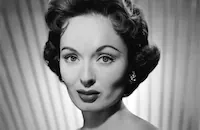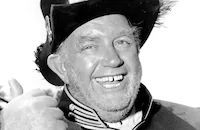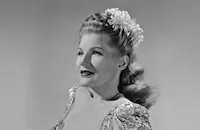Babes on Swing Street
Cast & Crew
Edward Lilley
Ann Blyth
Peggy Ryan
Andy Devine
Leon Errol
Anne Gwynne
Film Details
Technical Specs

Synopsis
Barber Joe Costello prefers to let his teenage daughter Trudy shave his customers while he plays the accordion. One day, Trudy's wealthy heiress friend, Carol Curtis, arrives at the Costello barber show and announces that Mr. Ansel of the Randall Institute of Music has agreed to audition the local kids for his private school. After the audition, Ansel agrees to offer the group ten scholarships, but informs the talented youngsters that there is still a minimum fee of twenty dollars per month. While the youngsters try to devise ways to raise the needed tuition money, Carol's snobbish spinster aunt Martha sets up trust funds for both her absentminded brother Malcolm and Carol from the family's vast real estate holdings. Meanwhile, teenagers Billy Harper and Corny Panatowski come up with the idea of opening a nightclub to raise the tuition money, and Carol offers to help them find a hall in which to house it. Learning of the youngsters' plights, Malcolm suggests that they convert the empty Curtis Hall into a nightclub, something he had been considering doing himself with band leader Freddie Slack. Knowing that his sister would never agree to such an idea, Malcolm convinces Martha that he needs the empty building as a studio for his oil painting. After a great deal of hard work, "Chez Enfants" prepares for its grand opening, but Carol is upset by the return of blonde bombshell Fern Wallace, her rival for Billy's affections. Martha then discovers Malcolm's scheme the day before the club's grand opening and orders the building evacuated. Afterward, Fern falsely accuses Carol of deliberately closing the show, and convinces Billy of as much. The next day, Malcolm pretends to be suicidal, so Martha agrees to reopen the club. When she discovers her brother's latest deception, however, she attempts to close it once again. Martha's plans are thwarted by the absentminded Malcolm, who learns that he is now fifty-two years old and, according to his parent's will, has already inherited the hall. The club is a big success, and Martha receives many mistaken congratulations from society friends who are in attendance. Malcolm is then granted his full inheritance, and Carol and Billy are finally united.

Director
Edward Lilley
Cast

Ann Blyth

Peggy Ryan

Andy Devine

Leon Errol

Anne Gwynne
Kirby Grant

June Preisser
Alma Kruger
Billy Dunn
Sidney Miller

Marion Hutton
Freddie Slack
The Rubenettes
Harry Shannon
Barbara Jean Wong
Pat Gleason
Charles Sherlock
Jimmy Lucas

Leonard Carey
Jean Trent
Eddie Bruce
Carey Harrison
Ferris Taylor

Ian Wolfe
Jack Mulhall
Olaf Hytten
Billy Newell
Bobby Scheerer
Ralph Hodges
George Rowland

Jerry Antes
Robert Coleman
Jack Lindquist
Elaine Campbell
Roy Fitzell
Terry Grafton
Crew
Jerome Ash
Bernard B. Brown
Alfred Bryan
Bernard W. Burton
Everett Carter
Eugene Conrad
Louis Da Pron
Albert De Bru
Howard Dimsdale
Fred R. Feitshans Jr.
Fred Fisher
Sam Freed Jr.
John P. Fulton
Russell A. Gausman
John B. Goodman
Charles S. Gould
Abraham Grossman
Inez James
Joe Lapis
Ernesto Lecuona
Sidney Miller
Vic Mizzy
Dolly Morse
E. R. Robinson
Milton Rosen
Milton Schwarzwald
Irving Taylor
Brenda Weisberg
Vera West

Film Details
Technical Specs

Articles
Peggy Ryan (1924-2004)
Born Margaret O'Rene Ryan on August 28, 1924, in Long Beach, California, Ryan began dancing professionally as a toddler in her parents' vaudeville act, the Dancing Ryans, and was discovered by George Murphy when she was 12. Murphy arranged for young Peggy to dance with him in the Universal musical Top of the Town (1937). She would go on to make a few more film appearances over the next few years - the most striking of which as a starving, homeless girl in John Ford's The Grapes of Wrath (1940) - yet for the most part, she was hardly noticeable apart from a few dance numbers.
Her luck changed when Universal cast her opposite another teenage hoofer, Donald O'Connor in What's Cookin'? (1942). From then on, they teamed in a series of innocuous musicals that were low on production values, but high on youthful pluck. Just check out some of their titles: Private Buckaroo, Give Out, Sisters!, Get Hep to Love (all 1942); Top Man, Mr. Big (both 1943); Chip Off the Old Block, This Is the Life, and Bowery to Broadway (all 1944). They may have not been high art, but jitterbuggin' kids loved it, and given the low investment Universal put into these pictures, they turned quite the profit.
Her career slowed down after the war. In 1945, she married songwriter James Cross, and didn't return to films until 1949, when she made two minor musicals that year: Shamrock Hill, There's a Girl in My Heart. She divorced Cross in 1952 and met her second husband, dancer Ray McDonald, in her final film appearance, a forgettable musical with Mickey Rooney, All Ashore (1953). Tragically, McDonald died in 1957 after a food choking incident, and the following year, Ryan moved to Honolulu after marrying her third husband, Honolulu Advertiser columnist Eddie Sherman. She kept herself busy teaching dance classes at the University of Hawaii, but in 1969, she found herself back in front of the camera as Jenny Sherman, secretary to Detective Steve McGarrett (Jack Lord) on the long-running show Hawaii Five-O,. She played the role for seven years, remaining until 1976.
Eventually, Ryan relocated with her husband to Las Vegas, where for the last few years, she was teaching tap dancing to a whole new generation of hoofers. She is survived by her son, Shawn; daughter Kerry; and five grandchildren.
by Michael T. Toole

Peggy Ryan (1924-2004)
Quotes
Trivia
Notes
The working titles of this film were Merrily We Sing and United We Sing. According to Daily Variety, this was the first film in which actress Peggy Ryan received top billing. Hollywood Reporter news items and production charts include June Vincent and Leo Carrillo in the cast, but they did not appear in the released film. Hollywood Reporter news items also include Bobby Brooks in the cast, but his appearance in the released film could not be confirmed.














